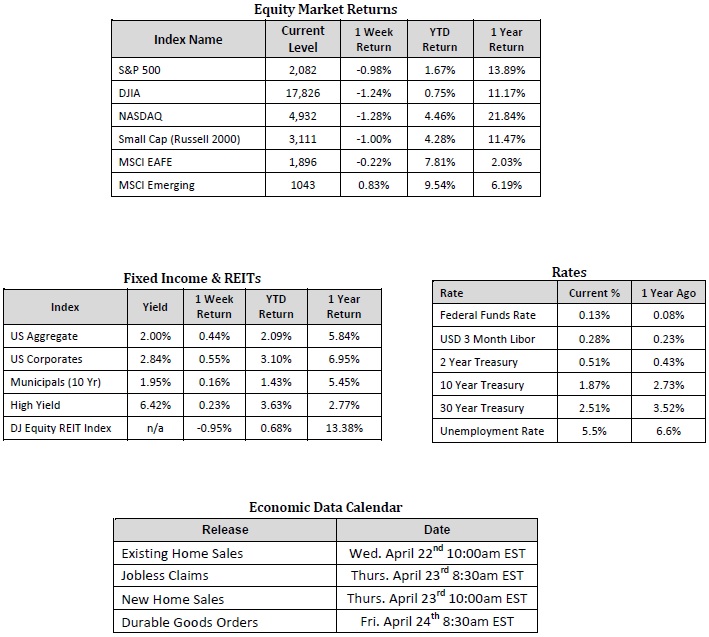
Capital Markets Update – Week of 04/20/2015
Market Overview
Sources: Rates Data and Economic Calendar—Bloomberg Markets as of 4/20/15; Equity Market, Fixed Income and REIT returns from JP Morgan as of 4/17/15.
Happening Now
Volatility Returns Amidst Conflicting Economic Reports
U.S. Stocks retreated last week as oil jumped 8% and the CPI (which is a measure of inflation) came in hotter than expected. The sell-off appeared broad-based with the S&P 500 index losing 0.98%, the S&P 400 Mid-Cap index losing 1.26% and the small cap-oriented Russell 2000 index falling 1.0%. As investors pay close attention to economic readings, not only to judge the future path of the U.S. economy but also in an attempt to time the Fed’s first rate hike, a batch of releases this week have fueled an increase in volatility. The Core CPI released Friday, which strips out volatile food and energy prices, posted a 0.2% increase for the month and a 1.8% gain over the past year. This was the second consecutive monthly gain after losing -0.7% in January.
Working backwards through time, Thursday’s Initial Jobless Claims report which was released last week pointed to some improvement in the April employment report. Initial claims rose 12,000 but, according to Bloomberg, “The 4 week average is little changed, up only fractionally to 282,750, which is 25,000 below the month-ago comparison.” Wednesday’s Industrial Production report showed production in March fell 0.6%, larger than the expected decline of -0.3%, and Tuesday’s Retail Sales report, while gaining 0.9%, rose less than the expected rate of 1.1%.
With U.S. equities selling off over the past week, the CBOE Volatility Index (VIX) gained 9.9%.What is fueling this past week’s increase in volatility? Perhaps it is the fact that the economic data the Fed is looking to before raising rates, namely employment and inflation data, are suggesting that the economy is on firmer ground, while the peripheral data, namely retail sales and industrial production data, are pointing to a slowdown in economic activity.
We believe that while volatility may increase during certain time frames throughout the year, investors should try to maintain a “big picture” perspective. The U.S. economy is continuing to improve when considering changes in year- over- year data.
Important Information and Disclaimers
Past Performance is not a guarantee of future performance.
Investing in foreign securities presents certain risks not associated with domestic investments, such as currency fluctuation, political and economic instability, and different accounting standards. This may result in greater share price volatility. These risks are heightened in emerging markets.
There are special risks associated with an investment in real estate, including credit risk, interest rate fluctuations and the impact of varied economic conditions. Distributions from REIT investments are taxed at the owner’s tax bracket.
The prices of small company and mid cap stocks are generally more volatile than large company stocks. They often involve higher risks because smaller companies may lack the management expertise, financial resources, product diversification and competitive strengths to endure adverse economic conditions.
Investing in commodities is not suitable for all investors. Exposure to the commodities markets may subject an investment to greater share price volatility than an investment in traditional equity or debt securities. Investments in commodities may be affected by changes in overall market movements, commodity index volatility, changes in interest rates or factors affecting a particular industry or commodity.
Products that invest in commodities may employ more complex strategies which may expose investors to additional risks.
Investing in fixed income securities involves certain risks such as market risk if sold prior to maturity and credit risk especially if investing in high yield bonds, which have lower ratings and are subject to greater volatility. All fixed income investments may be worth less than original cost upon redemption or maturity. Bond Prices fluctuate inversely to changes in interest rates. Therefore, a general rise in interest rates can result in the decline of the value of your investment.
Definitions
MSCI- EAFE: The Morgan Stanley Capital International Europe, Australasia and Far East Index, a free float-adjusted market capitalization index that is designed to measure developed-market equity performance, excluding the United States and Canada.
MSCI-Emerging Markets: The Morgan Stanley Capital International Emerging Market Index, is a free float-adjusted market capitalization index that is designed to measure the performance of global emerging markets of about 25 emerging economies.
Russell 3000: The Russell 3000 measures the performance of the 3000 largest US companies based on total market capitalization and represents about 98% of the investible US Equity market.
ML BOFA US Corp Mstr [Merill Lynch US Corporate Master]: The Merrill Lynch Corporate Master Market Index is a statistical composite tracking the performance of the entire US corporate bond market over time.
ML Muni Master [Merill Lynch US Corporate Master]: The Merrill Lynch Municipal Bond Master Index is a broad measure of the municipal fixed income market.
Investors cannot directly purchase any index.
LIBOR, London Interbank Offered Rate, is the rate of interest at which banks offer to lend money to one another in the wholesale money markets in London.
The Dow Jones Industrial Average is an unweighted index of 30 “blue-chip” industrial U.S. stocks.
The S&P Midcap 400 Index is a capitalization-weighted index measuring the performance of the mid-range sector of the U.S. stock market, and represents approximately 7% of the total market value of U.S. equities. Companies in the Index fall between S&P 500 Index and the S&P SmallCap 600 Index in size: between $1-4 billion.
DJ Equity REIT Index represents all publicly traded real estate investment trusts in the Dow Jones U.S. stock universe classified as Equity REITs according to the S&P Dow Jones Indices REIT Industry Classification Hierarchy. These companies are REITSs that primarily own and operate income-producing real estate.




